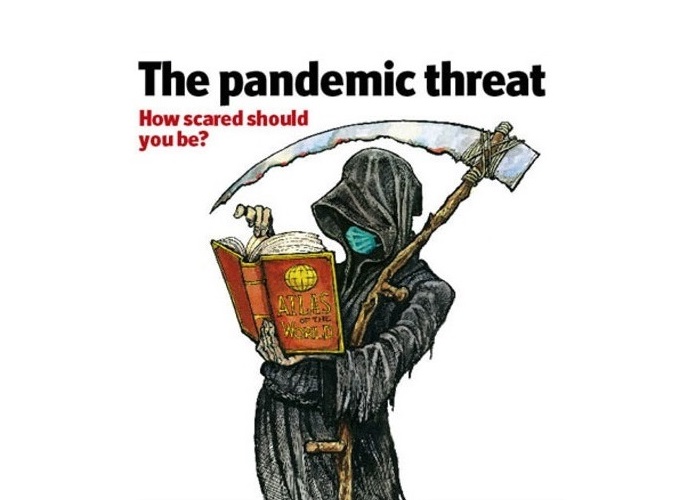The Pandemic threat
It’s deadly serious; so even if the current threat fades, the world needs to be better armed
IT IS said that no battle-plan survives contact with the enemy. This was certainly true of the plan drawn up over the past few years to combat an influenza pandemic. The generals of global health assumed that the enemy would be avian flu, probably passed from hens to humans, and that it would strike first in southern China or South-East Asia. In fact, the flu started in an unknown pig, and the attack came in Mexico, not Asia...
Вернуться на Главную

The hens, though, deserve some credit. The world has not had a pandemic (a global epidemic) of influenza since 1968. Four decades are long enough to forget that something is dangerous, and people might have done so had they not spent the past ten years considering the possibility that a form of bird flu which emerged in Hong Kong in 1997 might be one mutation away from going worldwide.
The new epidemic was raised on April 29th to just one notch below the level of a certified pandemic by the World Health Organisation. In an effort to halt the spread of the disease, Mexico’s president, Felipe Calderón, has announced that non-essential services should close down between May 1st and 5th, and people should stay at home. Part of the reason for worry is that, unlike ordinary flu, which mostly carries off the old, the victims of this disease are mostly young and otherwise healthy.
Still, this epidemic has not actually killed many people yet. That there have been a mere handful of confirmed deaths is probably the result of a lack of proper tests. But even if all the possibles are counted in, a couple of hundred fatalities cannot compare with the 30,000 deaths caused in America each year by seasonal influenza. So how scared should we be?
Damned if you do, damned if you don’t
As far as this epidemic is concerned, it’s too early to tell. One unknown is how widespread the virus is in Mexico. If it is ubiquitous, and had not been noticed earlier because it emerged during the normal flu season, then this epidemic may turn out to be insignificant, at least to start with. No flu death is welcome, but in this case the new disease might not increase the immediate burden greatly. But if the new strain is relatively rare, or what is being seen now is a more dangerous mutation of what had once been a mild virus, then the proportion of infected people dying may already be high. The death-toll, then, will rise sharply as the disease spreads.
Either way, the authorities were right to hit red alert. Influenza pandemics seem to strike every few decades and to kill by the million — at least 1m in 1968; perhaps 100m in the “Spanish” flu of 1918-19. And even those that start mild can turn dangerous. That is because new viral diseases generally happen when a virus mutates in a way that allows it to jump species, and then continues to evolve to exploit its new host. If that evolution makes the virus more virulent, so much the worse for the host. HIV, the AIDS-causing virus, lived happily and benignly in chimpanzees before it became a scourge of people. In Mexico, the early indications are that two pig viruses that can infect people but rarely pass from person to person recombined with each other to create a virus which does so easily.
Changes in virulence have certainly happened before in influenza epidemics, which have struck in successive waves of different severity. The message is that it makes sense to put money and effort into containing the new infection even if it does turn out to be relatively harmless today. The more people who have the virus, the more virus particles there are for that one, fatal mutation to appear in.
Resistance is another reason to try to contain an epidemic early. New antiviral drugs that were not around during past epidemics seem to be effective against the current outbreak. But natural selection is a powerful force, and if the spread of the disease means they have to be used widely, a resistant strain of the virus could easily evolve.
Don’t wait till winter
Now is the time to prepare for the worst. Flu — including pandemic flu — tends to be seasonal. The infection will probably tail off in the north over the next few months and head south as winter gets a grip on the Earth’s less populated hemisphere. It would make sense, therefore, to put the antiviral factories on overtime immediately, and try to develop, manufacture and distribute a vaccine.
Crash vaccine programmes pose their own risks. In 1976 flu vaccines killed a lot of people in America. But the growth of biotechnology means there are new ways of making vaccines and new types of vaccine to make. Mostly, these have been aimed at the threat of bird flu. But laboratories will already be clearing the decks to receive their first samples of the new swine flu, and getting to work on countermeasures.
And there is one further lesson. The system of checking for new diseases also needs to be improved. Partly because everyone was looking at Asia, no one was concentrating on Mexico. But as genetic sequencing becomes cheap and routine, it ought to be possible to pick dangerous mutations up quickly.
That would mean sending samples from doctors’ surgeries to a central laboratory dedicated to sequencing, even when nothing strange was suspected. And that would require organisation and money. Not every person with a sniffle need be tested — only a small, representative sample. But if this had happened in Mexico over the past few months, the generals of global health would have seen that something was coming down from the hills and they could have mobilised sooner.



































